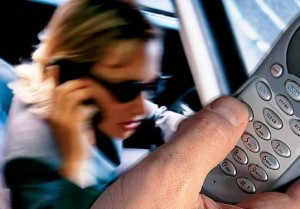
Despite clear evidence of the dangers of using cell phones will driving, national safety regulators are not doing anything.
The National Safety Council has just cited a study published in the Journal of Safety Research that says drivers overestimate their skills and underestimate distractions caused by other activities while they drive. Particularly dangerous is the widespread use of cell phones.
In January the NSC urged a total ban on that activity, based on scientific estimates that cell phone use while driving contributes to 6% of crashes, or 636,000 wrecks, 330,000 injuries, 12,000 serious injuries, and 2,600 deaths each year. NSC estimates the annual financial toll of cell phone-related crashes at $43 billion.
“Our nation has reached a point where we estimate more than 100 million people are engaging in this dangerous behavior daily,” said Janet Froetscher, NSC president. Froetscher added that the issue is not the type of phone a driver uses, rather it is the distraction caused by the conversation.
“Hands-free devices do not make cell phones any safer. Several studies indicate that the principle risk is the cognitive distraction. Studies also show that driving while talking on a cell phone is extremely dangerous and puts drivers at a four-times greater crash risk,” she said.
The latest study, led by William Horrey of the Liberty Mutual Research Institute for Safety in Hopkinton, Massachusetts, claims drivers may engage in other distracting activities while they drive because they don’t accurately perceive the danger of doing so.
The study involved 41 drivers who were willing to test the effects of engaging in other distracting activities while they drive.
Participants first demonstrated their driving ability in three areas: lane keeping, speed control, and quick response to a changing traffic light.
Next, they demonstrated these abilities while also performing a relatively easy distracting activity (recalling, adding, and repeating simple numbers presented while driving) and a relatively difficult one (developing and asking yes-or-no questions to identify an object while driving). Researchers expected that the more difficult activity would require more thought and thereby distract drivers more significantly from safe driving.
The results showed that the more difficult activity reduced driving safety more than the easier one. They also showed that drivers did not recognize one activity as more difficult than the other and estimated no difference between the activities’ affect on their driving abilities.
According to the researchers, these results, combined with previous studies, suggest that drivers are not aware of their own performance loss due to distraction.
“Today it is important to understand how new in-vehicle tasks affect drivers’ performance as well as how they affect drivers’ perceptions of their own performance,” the study concludes, noting that commercial drivers frequently have to deal with other distracting activities as part of their jobs, and the high cost of crashes to employers. The study also outlines the steep costs to employers of off-the-job crashes due to distracted driving, compounded by a national increase in the length of daily commuting times.
The Journal of Safety Research is a peer-reviewed scientific journal in the safety field. Its scholarly articles present basic and applied research in all areas of safety, including traffic, industry, farm, home, school and public.
NSC notes the following:
- Using cell phones while driving is a very high risk behavior with significant impact on crashes and society. More than 50 peer-reviewed scientific studies have identified the risks associated with cell phone use while driving.
- Drivers who use cell phones are four times more likely to be in a crash while using a cell phone. (1997 New England Journal of Medicine examination of hospital records and 2005 Insurance Institute for Highway Safety study linking crashes to cell phone records).
- There is no difference in the cognitive distraction between hand-held and hands-free devices. (Simulator studies at the University of Utah.)
- 80 percent of crashes are related to driver inattention. There are certain activities that may be more dangerous than talking on a cell phone. However, cell phone use occurs more frequently and for longer durations than other, riskier behaviors. Thus, the #1 source of driver inattention is cell phones. (Virginia Tech 100-car study for NHTSA)

I am not sure we needed a study to confirm that distractions can cause accidents. AAA at one time used the slogan “Driving is a full time job” They should bring the slogan back into use.
Sad isn’t it…